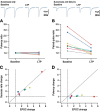Expression of NMDA receptor-dependent LTP in the hippocampus: bridging the divide
- PMID: 23339575
- PMCID: PMC3562207
- DOI: 10.1186/1756-6606-6-5
Expression of NMDA receptor-dependent LTP in the hippocampus: bridging the divide
Abstract
A consensus has famously yet to emerge on the locus and mechanisms underlying the expression of the canonical NMDA receptor-dependent form of LTP. An objective assessment of the evidence leads us to conclude that both presynaptic and postsynaptic expression mechanisms contribute to this type of synaptic plasticity.
Figures





References
-
- Bliss TV, Collingridge GL. A synaptic model of memory: long-term potentiation in the hippocampus. Nature. 1993;361:31–39. - PubMed
-
- Bliss T, Collingridge G, Morris R. In: The Hippocampus Book. Andersen P, Morris R, Amaral D, Bliss T, O'Keefe J, editor. New York: Oxford University Press; Synaptic plasticity in the hippocampus; pp. 343–474.
Publication types
MeSH terms
Substances
Grants and funding
LinkOut - more resources
Full Text Sources
Other Literature Sources

